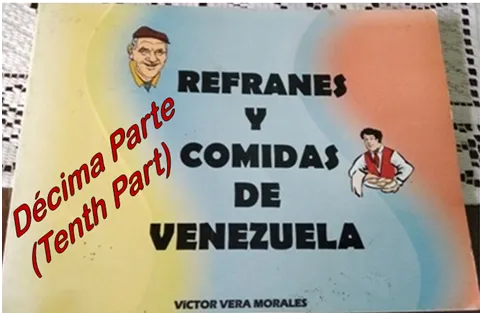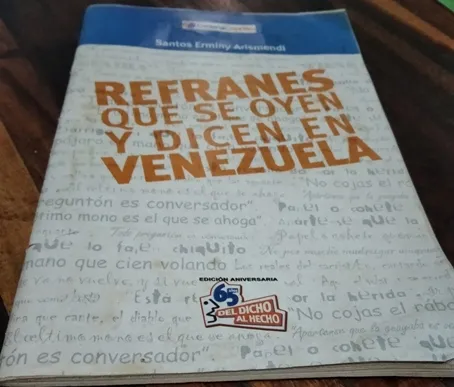Hola a todos compañeros de Hive Cross Culture!, espero que todos estén bien. Para hoy, y continuando con mi seriado “Cinco sabios refranes venezolanos”, les he traído la décima entrega de estas publicaciones; en donde presento cinco de los dichos más comunes en mi país; los cuales en este caso extraje del libro “Refranes que se oyen y dicen en Venezuela”, cuyo autor es Santos Erminy Arismendi, libro publicado por la Cadena Capriles en el año 2006, el cual venía encartado gratis en el periódico “Últimas Noticias”. Los comentarios que acompañan a cada uno de éstos, son íntegramente de mi autoría. Y como siempre, al final están los enlaces que les llevan a las nueve primeras entregas. Espero que los disfruten.


Es un refrán muy aplicable a aquellas personas que ven siempre los defectos ajenos, pero jamás se ven los propios. Muy similar al famoso dicho aquel que dice: “Ve la paja en el ojo ajeno, pero no ve la vigueta en el propio.”
Dicho muy similar a: “Pedirle peras al olmo”, quiere decir, que es imposible pedirle algo a alguien que no lo va a poder hacer o cumplir aún cuando quiera, porque se encuentra fuera de su alcance.
Este refrán es utilizado cuando se trata de decir que se requieren acciones radicales para finalizar un problema. Generalmente el bachaco existe en donde hay plantas, y si se meten chivos en el área, entonces se comerán toda la vegetación y el bachaco no tendrá que comer y morirá de hambre o simplemente se irá. Y en el caso del morrocoy, que se instala en un sitio, lo único que lo corre es el fuego o candela. De allí que se tomen estos dos ejemplos para señalar la severidad o extremismo que se requiere aplicar para resolver un problema.
Es un dicho muy similar al que dice “La burra siempre tira para el monte”; y lo que trata de decir, de forma despectiva, que las personas con defecto de carácter, siempre harán cosas malas o se unirán a personas de similar calaña. Es un refrán para expresar desprecio y desagrado.
Las novillas, son las hembras jóvenes de las reses; entonces, al referirse a una mujer de baja estatura con este dicho, indica que la mujer no envejece, o que aparenta por su estatura ser más joven de lo que realmente es.

Hello to all colleagues of Hive Cross Culture! I hope you are all well. For today, and continuing with my series" Five wise Venezuelan sayings ", I have brought you the tenth installment of these publications; where I present five of the sayings common in my country, which in this case I extracted from the book "Sayings that are heard and said in Venezuela", whose author is Santos Erminy Arismendi, a book published by Cadena Capriles in 2006, which was inserted free in the newspaper "Últimas Noticias". The comments that accompany each one of these are entirely my own. And as always, at the end are the links that lead you to the first nine installments. I hope you enjoy them.


It is a very applicable saying to those people who always see the defects of others, but never see their own. Very similar to the famous saying that says: "You see the straw in someone else's eye, but you don't see the joist in your own."
Said very similar to: "Ask for pears from the elm tree", it means that it is impossible to ask something from someone who will not be able to do it or fulfill it even when they want, because it is out of their reach.
This saying is used when it comes to saying that radical actions are required to end a problem. Generally, the bachaco exists where there are plants, and if goats are brought into the area, then they will eat all the vegetation and the bachaco will not have to eat and will starve or simply leave. And in the case of the morrocoy, which is installed in a place, the only thing that runs it is the fire. Hence, these two examples are taken to indicate the severity or extremism that is required to apply to solve a problem..
It is a saying very similar to the one that says "The donkey always runs for the mountain"; and what he tries to say, in a derogatory way, that people with a character defect will always do bad things or will join people of similar ilk. It is a saying to express contempt and dislike.
Heifers are the young females of cattle; then, when referring to a short woman with this saying, it indicates that the woman does not age, or that she seems younger than she really is because of her height.

Dear readers, below I place the links of the first nine posts, in case you want to read them:
Víctor Vera Morales. (Agosto 2004). Refranes y Comidas de Venezuela. Editado por el Instituto Municipal de Publicaciones de la Alcaldía de Caracas.
Santos Erminy Arismendi. (2006). Refranes que se oyen y dicen en Venezuela. Cadena Capriles, Caracas. Venezuela.
- Fotos de mi autoría, tomada con un teléfono REDMI 8A, intervenida con WordArt / Photos of my authorship, taken with a REDMI 8A telephone, intervened with WordArt.
- Los diseños incluidos en esta publicación, han sido elaborados por mi persona con la aplicación CANVA / The designs included in this publication has been made by me with the CANVA application.
In the event that it is required to use the content or images of this post and my other publications, I would be grateful if my authorship (Fabiola Martínez) was made and the corresponding link was cited. Thank you.

 CommunityIIDiscord
CommunityIIDiscord